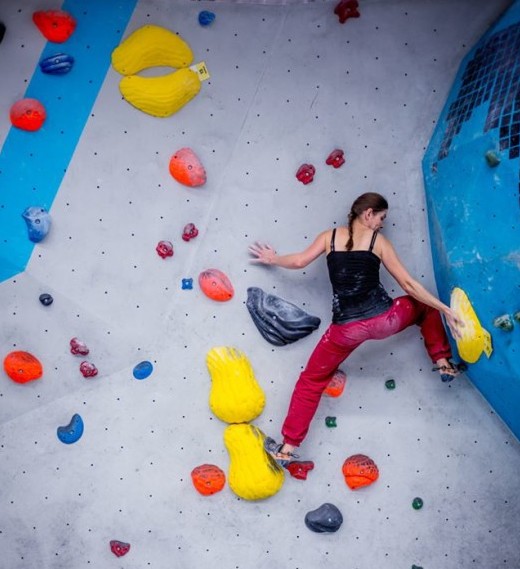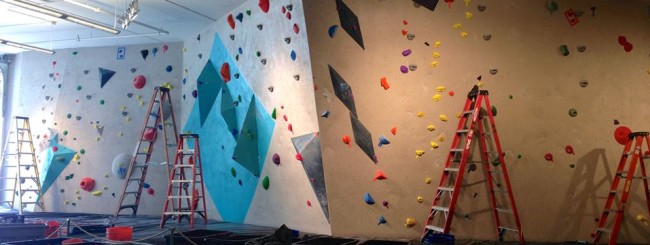
Do you want to save money? Increase your setters’ efficiency? Make your gym look fantastic? Then it may be time to ditch the tape that’s hanging off your climbing wall and move into the future with monochromatic routes and boulder problems.
What’s Monochromatic route setting you ask? It’s the process of setting all routes or boulder problems with the same colored holds. This does not mean every hold in the gym is blue! It means that each route will be designated by the hold color instead of tape color.
Advantages to Setting by Hold Color
- Long term cost savings
- Faster setting
- Environmentally sound
- Cleaner walls
- Less waste
- Faster striping of the wall
- No daily tape maintenance
- Fewer issues for color-blind climbers
Disadvantages to Setting by Hold Color
- Chalk and rubber may hide the color of the hold
- May need to have a lower density to keep routes separate
- Fewer hold options for routesetters depending on gym’s hold selection
- Hold companies have yet to standardize colors
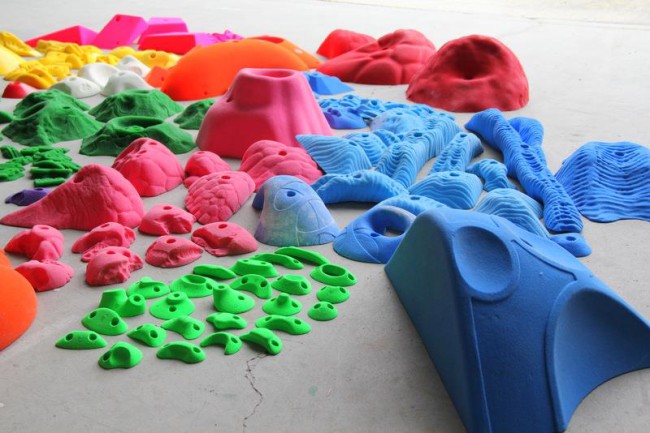
If you’re a new gym, making monochromatic setting standard practice is as easy as falling off a ladder. If your facility has been stuck on tape for years, don’t fret, you’re only a few steps away from freeing up your staff from tasks such as sticking, re-sticking and peeling off tape.
The Six Basic Steps to Going Mono
1. Start by setting routes and problems with monochromatic holds, but still use tape. This will allow your members to get used to seeing color-coordinated routes and they will soon catch on that different routes have different colors. Next you’ll be able to eliminate the tape. Set some areas without tape and once your members get the hang of it, slowly move on from sector to sector, removing the tape and leaving behind beautiful looking monochromatic problems.
2. Having colored routes will look great and your members will notice. But make sure you have a proper communication plan so you don’t leave climbers dazed and confused. Hang posters with details on the monochromatic setting. Share the changes on your social media sites. Put up a Q&A or comment board. Make sure you have enough staff during the first few weeks to walk the floor answering questions and soliciting feedback.
3. Try to limit your routes to a maximum of six different colors; there is no need to have a dozen or more colors as they won’t be differentiated enough. These colors are ideal because of their brightness and distinctness: Red, Blue, Yellow, Green, Orange, Purple.
Unless your gym is huge and you can keep the slightly different colored routes away from each other, stay away from ambiguous colors like grey and pink; avoid multi-colored holds because they just look ugly and will confuse the crap out the climbers. If you must, you can also include black and white in your color scheme, but keep in mind that black tends to turn grey from climbing chalk and white turns grey from shoe rubber.
4. Monochromatic route setting works best if all your hold colors are of the same exact color; all your reds need to be the exact same hue of red. No scarlet, pink, or faded orange. When ordering new holds, purchase from companies that can guarantee all the colors will match. Some hold companies already offer standard Pantone or RAL colors, and hopefully they will all move toward this direction. If your favorite grip maker isn’t doing this already, let them know it’s something your gym wants!
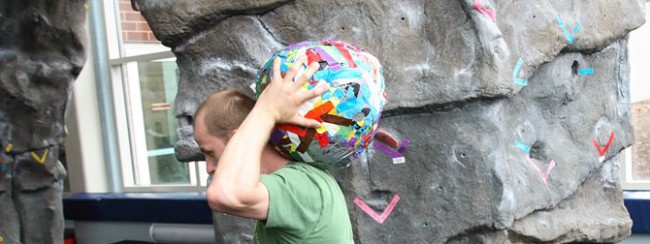
5. Sell off all those ugly, multi-hued, faded and chipped holds. Don’t leave them lying around for a setter to get a crazy idea in her head like setting some “retro” Yaniro route!
6. Clean off all the tape and never buy it again! This is really the best part. Ordering tape only to use once and then throw it away is extremely wasteful. Even though tape balls are cool they’re wasteful too. Ordering colored holds is like putting solar panels on the roof of your house: Expensive at first but quickly pays for itself over the life of your gym (although, we haven’t heard of any monochromatic tax credits, yet).
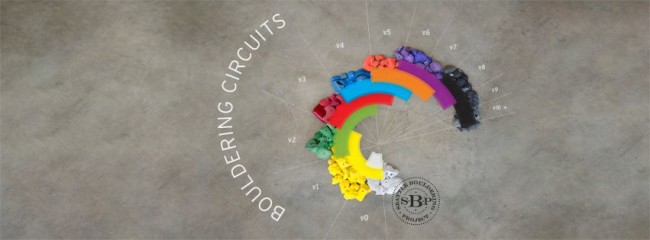
Advanced Monochromatics (AKA Circuits)
It is only natural to think that hold or tape color corresponds to a difficulty level. “So, are the blue routes easier than the red routes?” has been heard in every gym ever built. So why not go along with this completely commonsense approach. Once you have rid your gym of nasty tape you’ll have the perfect opportunity to start setting circuits. Circuits are set so that each hold color designates a difficulty level. For example all red holds will be V2 – v4 or 5.11a – 5.11d. Why not make it easy on your customers and give them what they intuitively want, while getting them away from chasing grades!

Climbing Business Journal is an independent news outlet dedicated to covering the indoor climbing industry. Here you will find the latest coverage of climbing industry news, gym developments, industry best practices, risk management, climbing competitions, youth coaching and routesetting. Have an article idea? CBJ loves to hear from readers like you!




